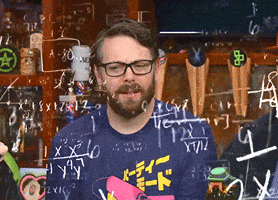Even worse. 90 in old Danish is “halvfemsindstyve” but it is rarely used today. The “sinds” part is derived from “sinde” means multiplied with but it is not in use in Danish anymore. That leaves halvfems, meaning half to the five (which is not used alone anymore) and tyve meaning twenty (as it still does).
We are in current Danish shortening it to halvfems which actually just means “half to the five” in old Danish (2.5) to say 90. 92 is then “tooghalvfems” (two and half to the five, or 2+2.5). The “sindstyve” part (multiplied with 20) fell out of favour.
So we at least have some rules to the madness. Were just not following them at all anymore.
How did you guys even get to this thought process for saying this sort of thing? Why would you work in fractions for whole numbers in language to start? Is this a monarch thing like they fancied themselves a math wizard so they said it like it was a solution on countdown and others mimicked to keep them happy/sound smart themselves?
The reason is that the Danish numbering system is based on a vigesimal (base-20) system instead of the decimal system. Why is a good question but it might have been influenced by French during a time where numbers from 50-100 is less frequently used, making them prone to complexity. The fractions simply occur since you need at least one half of twenty (10) to make the change from e.g 50 to 60 in a 20-based system.
ancient danes counted with their toes too lmao
That’s the technical reason, another reason is that the Danes tried to out-French the French, as they were very hip at the time.
But how did Danish end up like that even though it’s quite similar to Germanic languages and obviously neighbouring Germany?
English also has words like dozen (12) and score (20).
I guess it came from the physical counting in trading. Imagine counting 96 small items. It makes sense to group them into scores and then count the scores. 1 score 2 score 3 score 4 score and a half score. Then there are few remaining that didn’t fit it neatly in scores and then counted last. That’s a total of 1, 2, 3, 4, 5, 6 plus the 4 and a half scores.
No idea. We probably had a period where we traded a lot with the French and got influenced by the vigesimal system that way, creating the abomination of a Frankenstein monster we have today.
why would you avoid the fraction and use it up to 100 then minus 8. I dont have a lot of an issue with it being base 20 but the idea that talking in numbers you have to know fractions for a child is WILD to me. You have to do like a month of understanding math fractions to get how to speak whole numbers.
We don’t really learn the reason, we just memorise the word for the number. Kinda like you know the word “dog” means a four legged cute creature, but not why the name is “dog”. The old rules are not something we are teached, I just got curious after a confused foreigner made me think about the system for a second :p
Little fun-fact: We still have a trace of this left in Norwegian, where the most common way to say “1.5” is not “en og en halv” (“one and a half”) but “halvannen” which roughly translates to “half second”.
We abandoned the “half third”, “half fourth” etc. very long ago (if we ever used them), but “halvannen” just rolls nicely off the tongue.
In polish, “półtora” means one and a half, it comes from a proto-Slavic word meaning “half-second” for some reason
We actually still say “halvanden” in Danish too. Everything else is not used (except for halvfems which means 90…)
You also use halv tres (50) and halv firs (70) don’t you?
Halvfjerds for 70 but yes. Firs is 80 though, so that doesn’t make in much easier.
Fjerde = fourth, fire = four. That makes “half to the fourth” become “halv til fjerde” or “halvfjerds” while “four times twenty” becomes “firsindstyve” and shortened to new Danish “firs”
Halvannan is used in Sweden too. In retirement homes…
How
Why
Dane here. My guess is utter madness resulting from a history of overdosing on fly agaric filtered through the urine of slaves, followed by a distressingly long period of Catholicism.
Frankly, it’s a wonder that our ancestors didn’t come up with an even MORE bizarre way of saying numbers and other things!
Also I’m pretty sure losing folks to stupid wars in England didn’t help, the Great Heathen army and the conquest of England by Sweyn Forkbeard come to mind. No the relative prosperity and peace of Cnut the Great doesn’t make up for the theoretical brain drain.
When I’m in Denmark and have to say 92 I just say “kamelåså”
Syglekole?
You just ordered a thousand litres of milk
That’s actually happened a couple of times in Denmark (accidentally and after the sketch was released) https://www.tv2.no/nyheter/utenriks/span-data-lab-colortxt-blue-classtxt-blue-idext-gen1386kamelasa/span-dansk-kjopmann-skulle-ha-270-liter-melk-fikk-2575-liter/7268663/
Oh man, that takes me back.
I love how halvfems exists but fems doesn’t (and I guess it never did)
(5-0,5)x20 = 4,5x20 = 90? 2+((5-0,5)x20) = 2+(4,5x20) = 2 + 90 = 92?
- Half to the five = (5-0.5) = 4.5
- “Sindstyve” = multiplied by 20
- 4.5*20
- Two and half to the five multiplied by twenty = 2+(5-0.5)*20 = 2+4.5*20 = 2+90 = 92
Oh! That makes my brain hurt a bit less. It’s “subtract half from five”.
Yeah, it’s kinda the difference between saying “the clock is currently half past twelve” (the English way) and “the clock is currently half to one” (which we say in Danish and probably in a wealth of non-English languages too).
This is making my brain hurt. I need to try reading a few more times but, if I am understanding it correctly, the old Danish way of saying it is mathematically incorrect?
Half-to-five == 2.5
2.5*20 == 50
…
Did I read that correctly?
I think it means half less than 5, or 4.5
Maybe you’d say “half until 5” in english
for no particular reason, in English, 5:30 can be said as “half past 5” but never “half until 6”. (but “five thirty” is still more common)
Quarter-past the hour, and quarter-till, are still common. Though perhaps less common as we move towards digital clocks.
I’m not Danish, but I think he meant 4.5 instead of 2.5. It’s like halfway from 4 to 5, not from 0 to 5.
A similar word exists in Finnish too, when going from 1 to 2: “puolitoista” translates to “half second”, like halfway to the second number, and is commonly used to refer to 1.5, BUT without any multiplication shenanigans.
Correct.
- Half to the second (halvanden, still in use today) = 1.5
- Half to the third (halvtredje) = 2.5
- Half to the fourth (halvfjerde) = 3.5
- Half to the fifth (halvfemte) = 4.5
And so on. You might notice that I sometimes write it like “halvfemte” and other times “halvfems”. The latter is just the way it was spelled when used in a combined word (another fun quirk in Danish that we inherited from Germanic this time!). 90 is today spelled just “halvfems”.
Sorry to ping you a bunch with replies. I’m curious now, do you have unique numeral symbols for the numbers after 9?
No, we use the same numeral symbols as everyone else. We just pronounce it in the most unintuitive manner possible.
I can imagine that we once had symbols representing the base 20 system but standardised at some point to decimal symbols. I though haven’t encountered any piece of history to back that up.

I’m German and our way of counting is genuinely stupid. 121 would translate to “onehundred one and twenty”. You’d think it’s just a matter of practice but errors related to mixing up digits are statistically more common in German speaking regions. Awesome when it comes to stuff like calculating medication dosages and such. Like it’s not a huge issue but it’s such an unneccessary layer of confusion.
Its so annoying with phone numbers as well, depending how someone pronounces is. My mom always says phone numbers in 2 digits, like 06 12 34 56 78 (06 twelve fourandthirty sixandfifty eightandseventy) and you just get confused because you want to type in the first number pronounced
Phone numbers should always be said by individual digits, makes it simpler and faster to type as you’re listening
In some languages, pairs work fine.
Surprisingly, even English does it correctly
except 13-19 at least
Absolutely agreed
Yes! I’m German and I hate it. It’s also very inconvenient when entering numbers into a spreadsheet or something, because you have to know the whole number before you can start typing it.
As a non-native working in German, the numbers are one of the trickiest parts.
My jobs generally involve a lot of math and discussions of numbers, and I often struggle with swapping numbers around in my head. Especially because when you get to bigger numbers people often switch between (or use a combination of) listing individual digits left-to-right and saying multi-digit numbers.
The though is when you occasionally notice natives mess it up!
My experience living in The Netherlands (which has a similar system) as a non-native whose mothertongue is from the Romance branch is that you eventually get used to it. I think that’s because as your language skills improve you just stop interpreting the parts of the number individually and handle hearing and speaking those “nastier” blocks of two digits as if the whole block is a language expression.
Even better the apparently flip-flopping between one way of ordering digits and another one in longer numbers (for example: “two thousand, five hundred and two and ninety”) actually makes the strategy of “everything between 0 and 99 is processed as an expression” viable (i.e. “two thousand” + “five hundred” + “two and ninenty”), whilst I’m not so sure that would be possible if instead of just memorizing 100 numerical language expressions we had to do it with 1000 or more.
(If you’re not a French native speaker and you learn the language you might notice something similar when at some point your mind switches from interpreting “quatre-vingt” as “four twenty” to just taking it in whole block as an expression that translates to eighty)
The older generation in Norway also uses that format. I usually tell them that we aren’t under German occupation anymore, so they should use the sensible format.
Funny thing: it is the correct way to count like that, also in english. Four-teen, eight-teen etc. They just turn that around beginning with twenty. How obscure is that shit, when you really think about it?
It just feels weird saying it the other way tho
For a real explanation of this watch this illuminating video.
TL;DW According to the perons, it’s based on counting sheep and from base 20. 1 score = 20 sheep. 2 score = 40 sheep.
To get to 50, you have 2.5 score, but they don’t say “two and a half”. They are quite Germanic and say “halfway to 3” (Germans do this too). So, 50 = half three score.The video also points out that English has (as the hodgepodge of a language it is) yet another remnant of Germanic languages: 13-19 are not “te(e)n-three to te(e)n-nine”, but “three-te(e)n to nine-te(e)n”, just like in German “drei-zehn bis neun-zehn”.
It’s quite easy to mock other languages, but there’s always a reason for why things are the way they are. Think of Chesterton’s fence.
There’s also a reason for imperial measurements, but it’s still a worse system than metric.
What’s your suggestion for a change to the Danish counting system? Do you think it is as obvious as going from imperial to metric?
Yes.
Stop being weird, Danes, literally everyone else figured it out.
It’S tHeiR gErmaN hEriTaGe
If the Frisians can figure out how not to be a bunch of weird number freaks while running around on clogs on their dikes and being half fucked up French the Danes have no excuse.
I agree with your broader point about linguistics, but Chesterton’s fence has never sat right with me. Consider the inverse:
This annoying and unnecessary fence is an inconvenience, but since nobody can remember what it’s for, we dare not remove it
Chesterton’s fence is a warning not to commit this logical error: I don’t know what this fence is for, therefore I know there is no reason for it.
It doesn’t say never to remove it. It means you should try and figure out why it’s there and ask around before removing it.
It’s just a logic exercise that advicates forethought when enacting change. The bigger problem is people taking parables and thought experiments as gospel, faithfully adhering to the text without considering it’s intent.
More people need to read Asimov’s Foundation
I honestly don’t understand what’s insightful about it. It encourages a functional viewpoint that results in you inventing proposed uses for something that is a vestige of an inefficiency. Justifying something useless isn’t curiosity, it’s just masturbation. You should identify how a structure interacts with it’s current environment. There’s a reason functionalism is considered worthless in sociology.
I think the point is more that you should take care to consider why it was put there because it might be something that is not immediately obvious.
You should identify how a structure interacts with it’s current environment.
OK, but what if it was put there to stop something that only happens once every 10 years? Without taking the time to learn this, you might tear it down and then after a few years you’re scrambling to solve a problem that was already solved.
there’s always a reason for why things are the way they are
Of course, no one is saying that the Danes were so drunk that they simply wanted to make their numbering so much different than everyone else. The problem is that they don’t want to change it, probably because “it has always been this way” or something.
Even Norwegian, which was historically more like Danish, changed to using “normal” counting in the 1950s. So it can be done, but Danes seemingly don’t want to change, despite the fact it makes their language harder to learn/use.
It’s a shame that, when Norwegians changed their counting system, the suggestion of using “to-ti” didn’t catch on for 20. It would be analogous to saying “twoty” in English.
Change it to what? Twenty-one? One Twenty? Four times twenty and one? Four time twenty plus ten and five? You could go the Germanic way, the Anglo-Saxon way, or the French way. Probably there are more ways to express numbers.
It’s not as straight forward as imperial to metric, where metric is logical and imperial isn’t. A vigesimal system is logical, just like binary or hexadecimal.
even imperial had a logic when it was made, same with every old measurement system. Everyone has hands, fingers, and arms boom you have small scale. The acre was once just what a single ox and plow could do in 1 day. there was never a need to square feet per acre, who would ever need that. Plus look at how old system were written. Try uses the metric system with roman numerals.
How many inches are there in a foot? How many in a yard? How many in a mile? More importantly: why? The foot is from a duodecimal system (12 points = 1 line, 12 lines = 1 inch, 12 inches = 1 foot), but then then suddenly 3 feet = 1 yard.
Also the imperial system is simple, not logical. Sure, it’s based on body parts and simple things like that, but every moron could’ve seen that hands have different sizes. Now you have about 3 imperial systems (international, British, US) maybe more even more if the old colonies invented more units. Everyone knows the way forward for units it the SI units. It’s logical, it’s straight forward, and it’s used worldwide - except for a minority of regions that are staunchly are against it.
but there’s always a reason
By and large, there’s a reason for everything, but it’s just not always a good reason.
If I have 100 rocks and take away 8, the answer to how many rocks I Have should not require a math problem. We’re counting, not making change. If your counting system isn’t decimal-based, you’re no better off than the US using imperial measurements.
This comment makes me so sleepy…
I just tried to say tentyfive like four times in a row and I couldnt speak for 20 seconds after that. Thank you.
Norway used to count like the Germans, but switched after the introduction of the telephone. There were simply too many mistakes when telling the numbers to the operators, that a change was mandated.
Old people might still use the 2+90 variant though, but it is not very common.
So now you’re calling me old? THE NERVE!
Fun fact, english used to count the same way as german, and it still has the numbers in “reverse” from 13 to 19.
Eleven and twelve kinda are as well. They literally mean “one left” (ain-lif) and “two left” (twa-lif) with the “over ten” being implied.
I’m 43 years old and this is the first time I’ve seen an explanation of these numbers. Thank you!
German’s my first language and I am kinda proficient in english but I never realized that the english numbers 13 to 19 work like like ours…
French is pretty stupid too. Smart Belgium with french as national tongue only changed that number aberration: They use the made-up word “octante” for eighty and “nonante” for ninety, instead of “quatre-ving” (four-twenty) or “quatre vingt dix” (four-twenty , ten) in proper french
What if I told you that all words are made up?
In Belgium we use nonante, not octante, that is, iirc only used in Switzerland. That means we at least don’t use quatre-vingt onze etc.
Dunno, I prefer french to spanish tbh. Maybe its because basque is like French.

Ehh, i’m not giving France a pass either.
The answer to 100 - 8 should not be four twenties and a twelve. We’re counting, not making change.
French counting is bunk. Way, Way, better then Denmark though apparently
the thing nobody mentions is that the 4x20 part became a word that just means 80 in people’s mind, it kinda not literal anymore, but the Swiss and Belgian ways are still better (edit the 4x20+10 is similarly just 90)
Most Danes does not know how 92 is constructed - it is just as picture one, second calculation: 2 and halvfems = 92.
However, I do feel like we’re using Imperial unites.
(edit the 4x20+10 is similarly just 90)
I can let you get away with the first part about 4x20 just becoming the word for 80, but with this one, you’re just fooling yourself and others.
If it were just another word for ninety, than ninety-two would be (4x20+10)+2 instead of 4x20+12 And it works that way up to 96.
Just stop making excuses and own the weirdness.
… I would say that’s more about 10 and 12 having their on words, we don’t say ten two, it’s a bit of a shortcut? Then after 16 we stopped caring and didn’t make new words, sticked to 10 7, 10 8, 10 9 for some reason, that IS weird. Unless you take into account that base 10 wasn’t always the norm and maybe it made sense to have dedicated words for numbers up to 12 or 16 because they were commonly used quantities or alternative counting bases idk. See I can find (blurry memories of, needs sources) good reasons ;p The point being people say 4 20 12 but only think 92.
e a word that just means 80 in people’s mind, it kinda not literal anymore, but the Swiss and Belgian ways are still better (edit the 4x20+10 is s
And if it was 28 syllables, it would still be 80 in people’s minds. But the words are still four twenty ten eight for what could easily just be nine eight.
I get it, but it is really inefficient for something as oft used as counting.
If it makes you feel better, English is full of crap like that which doesn’t make any sense and I’ll own that as a trash language :)
I think the first picture jumps over a little bit of calculation:
9 x 10 + 2
2 + 9 x 10
p.s. The third one makes total sense!
Bit of a sidenote.
Are the English numbers 11-20 influencer by the base 20 system of french back when we had French speaking royalty? And for some reason they’re the only unique “digits” for lack of a better term that survived because once we get to twenty it’s a pure base 10 system with a consistent pattern throughout.
I’m hoping someone more knowledgeable than me can tell me if my thinking is correct or not.
Edit: thanks for the history lessons, were interesting to read through.
No, 1-12 are influenced by the old base 12 Germanic/Norse system, which is why -teen starts at thirteen, same as in German (11: elf, 12: zwölf, 13: dreizehn, 14: vierzehn & so on)… The -teen for 1x in english is also a carryover from this, being threeten, fourten, fiveten etc. with only numbers over 20 having their orders reversed - German has something similar with “und” only appearing in numbers over 20. English did historically too, eg. “four and twenty blackbirds”.
Base 20 was historically used for large numbers though, eg “four score and seven years” by Abraham Lincoln, which was a poetic way of saying 87 inspired from Psalms 90:10, which says “The days of our years are threescore years and ten; and if by reason of strength they be fourscore years, yet is their strength labour and sorrow; for it is soon cut off, and we fly away.” in the King James Version, which reflects that using base 20 for large numbers (and not just 80) was not uncommon in the 17th century.
Seems like they’re not, although I get your thought process. If we take Old English (which was English before the Norman conquest) and modern Swedish (since Sweden was never conquered by anyone from France or the Romans) as comparisons, we have
Eleven: OE endleofan, Swedish elva Twelve: OE twelf, Swedish tolv Thirteen: OE threotiene, Swedish tretton Fourteen: OE feowertiene, Swedish fjortun
I think you can see the pattern. These actually all have similar common ancestors going into Proto-Germanic, so they’re way older than the French influence on English.
Since other Indo-European languages like German and Russian do the same thing as English where the line between “one word numbers” and “two word numbers” is 20 to 21, I suspect that originates waaaaay back in the history of these languages
Ugh okay here’s another “Danes shouldn’t be allowed to make number stuff”:
The time 15:25 is “five minutes before half 4”
“Fem minutter i halv fire”
So you round up to 16 before even halfway, what!?
That makes perfect sense to me though. In Swedish we’d say fem i halv fyra. Five minutes to half four.
But in English half four would be short for half past four. I guess.
Counting like the Danish, however, that is an abomination.
What’s wrong with “25 over 3?” I see the need for half 4 by itself but things being relative to that is so weird to me
Well, it’s interesting because that would be the case with 15:20. That’d be tjugo över tre (twenty past three). But specifically 15:25 would be fem i halv fyra (five to half four). 15:35 is fem över halv fyra (five past half four).
And then 15:40 is tjugo i fyra (twenty to four).
So :25 and :35 are weird edge cases.
Agree - even “3 25” would be perfectly normal.
Man 3:25 is right there
Same in Dutch,
“Vijf voor half vier”
I’m very Danish and refuse to adhere to this nonsense. It’s pronounced “three twenty-five”.
Jeg elsker dig for det
They must have meant 9*10+2 for most of the countries. For French and Danish you would just remember the word for 90 instead of using logic to get there so they are actually quite 90+2.
So do you mean to suggest “quatre-vingt-dix” just means 90 and doesn’t also mean “four-twenty-ten”?
Well quatre-vignt-dix is literally translated to “four twenty ten” (why not just nine ten? because historically french evolved with a base 20 counting system).
But when a french person hears that, they don’t hear those numbers, to them it just means ninety.
Just like an english person won’t hear. “four-ty”, and think “four-ten” “oh that’s 40”. Because “fourty” was originally “four-ten” (written differently because old english so I rewrote in modern for simplicity) and got shortened down.
To them “fourty” is just a word that means 40. Just like to metropolitan french people “ quatre-vignt-dix” is just a word that means 90.
You’re right. Only Denmark deserves 2+90.
And the Germans
Don’t they do 2+9*10?
Four and twenty blackbirds baked in a pie…
That still fits the pattern of “bigger number, then smaller number.”
True. It does match the French pattern of 4x20+x.
It does exactly, and I didn’t notice that. “Four score and twelve.”
Your coloration took an innocent map of Europe and somehow made the thumbnail look dirty. Good job!
Four score and a dozen.
93= Four score and a baker’s dozen.
shakes fist THE DANES!
@ObviouslyNotBanana Ninety-two → Nine-ty-two → 9x10+2 :troll:



























